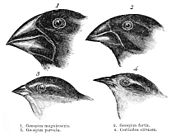
Last universal ancestor

The last universal common ancestor (LUCA), also called the last universal ancestor (LUA), concestor, or (incorrectly) progenote, is the most recent population of organisms from which all organisms now living on Earth have a common descent. LUCA is the most recent common ancestor of all current life on Earth. LUCA is not thought to be the first living organism on Earth, but only one of many early organisms, whereas the others became extinct. The last universal common ancestor (LUCA), also called the last universal ancestor (LUA), concestor, or (incorrectly) progenote, is the most recent population of organisms from which all organisms now living on Earth have a common descent. LUCA is the most recent common ancestor of all current life on Earth. LUCA is not thought to be the first living organism on Earth, but only one of many early organisms, whereas the others became extinct. While there is no specific fossil evidence of LUCA, it can be studied by comparing the genomes of its descendants, all organisms whose genomes have yet been sequenced. By this means, a 2016 study identified a set of 355 genes inferred to have been present in LUCA. This would imply it was already a complex life form with many co-adapted features, including transcription and translation mechanisms to convert information between DNA, RNA, and proteins. However, some of those genes could have developed later and spread universally by horizontal gene transfer between archaea and bacteria. Studies from 2000 to 2018 have suggested an increasingly ancient time for the inception of LUCA. During 2000 estimations suggested LUCA existed 3.5 to 3.8 billion years ago in the Paleoarchean era, a few hundred million years after the earliest evidence of life on Earth, for which there are several candidates. Microbial mat fossils have been found in 3.48 billion-year-old sandstone from Western Australia, while biogenic graphite has been found in 3.7 billion-year-old metamorphized sedimentary rocks from Western Greenland. Studies of 2015 and 2017 have tentatively proposed evidence of life as early as 4.28 billion years ago. A study of 2018 by the University of Bristol based on the application of the concept of a molecular clock indicate the LUCA existed at a time close to but not including 4.5 billion years ago, within the Hadean. Charles Darwin proposed the theory of universal common descent through an evolutionary process in his book On the Origin of Species in 1859, saying, 'Therefore I should infer from analogy that probably all the organic beings which have ever lived on this earth have descended from some one primordial form, into which life was first breathed.' Later biologists have separated the problem of the origin of life from that of the LUCA. By analysis of the presumed LUCA's offspring groups, the LUCA appears to have been a small, single-celled organism. It likely had a ring-shaped coil of DNA floating freely within the cell, like modern bacteria. Morphologically, it would likely not have stood out within a mixed population of small modern-day bacteria. However, Carl Woese et al., who first proposed the currently-used three domain system based on an analysis of ribosomal RNA (rRNA) sequences of bacteria, archaea, and eukaryotes, stated that in its genetic machinery, the LUCA would have been a '...simpler, more rudimentary entity than the individual ancestors that spawned the three (and their descendants)'. While the gross anatomy of LUCA can only be reconstructed with much uncertainty, its biochemical mechanisms can be described in some detail, based on the properties currently shared by all independently living organisms on Earth. The genetic code was likely based on DNA, with multiple DNA-binding proteins, such as histone-fold proteins, being traced back to LUCA. However, other studies propose that LUCA may have been defined wholly through RNA, consisted of a RNA-DNA hybrid genome, or possessed a retrovirus-like genetic cycle with DNA serving as a stable genetic repository. If DNA was present, it was composed exclusively of four nucleotides: deoxyadenosine, deoxycytidine, deoxythymidine, and deoxyguanosine. The DNA was kept double-stranded by a template-dependent enzyme, DNA polymerase. The integrity of the DNA benefited from a group of maintenance and repair enzymes including DNA topoisomerase. If the code was DNA-based, its genetic code was expressed via single-stranded RNA intermediates. The RNA was produced by a DNA-dependent RNA polymerase using nucleotides similar to those of DNA, with the exception that the DNA nucleotide thymidine was replaced by uridine in RNA. The genetic code was expressed into proteins. These were assembled from free amino acids by translation of a messenger RNA via a mechanism of ribosomes, transfer RNAs, and a group of related proteins. The ribosomes were composed of two subunits, a big 50S and a small 30S. Each ribosomal subunit was composed of a core of ribosomal RNA surrounded by ribosomal proteins. Both types of RNA molecules (ribosomal and transfer RNAs) played an important role in the catalytic activity of the ribosomes. Only 20 amino acids were used, only in L-isomers, to the exclusion of countless other amino acids. ATP served as an energy intermediate. Several hundred protein enzymes catalyzed chemical reactions to extract energy from fats, sugars, and amino acids, and to synthesize fats, sugars, amino acids, and nucleic acid bases through various chemical pathways. The cell contained a water-based cytoplasm effectively enclosed by a lipid bilayer membrane. The cell tended to exclude sodium and concentrate potassium by means of specific ion transporters (or ion pumps). The cell multiplied by duplicating all its contents followed by cellular division.The cell used chemiosmosis to produce energy. It also reduced CO2 and oxidized H2 (methanogenesis or acetogenesis) via acetyl-thioesters.
